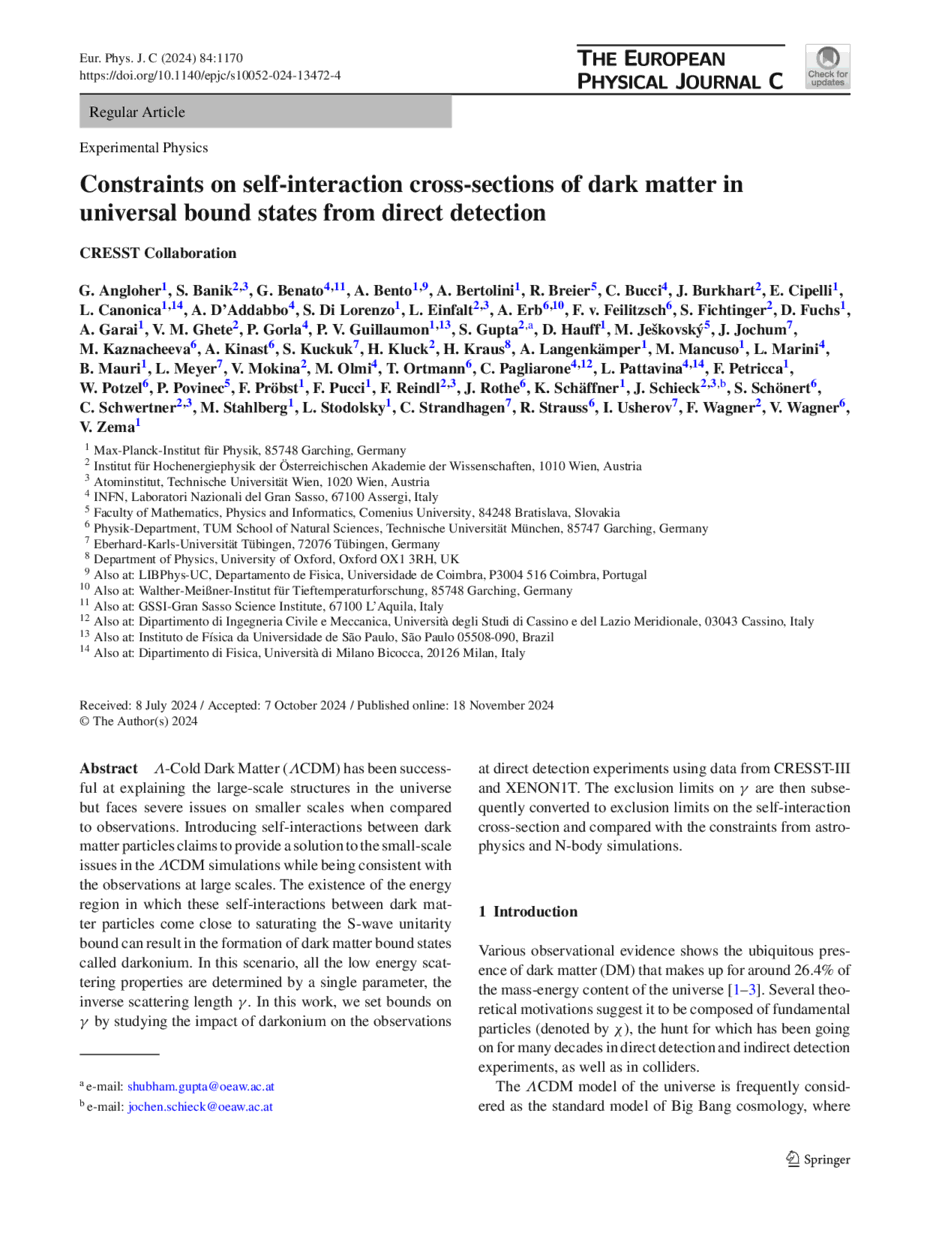https://doi.org/10.1140/epjc/s10052-024-13472-4
Regular Article
Constraints on self-interaction cross-sections of dark matter in universal bound states from direct detection
1
Max-Planck-Institut für Physik, 85748, Garching, Germany
2
Institut für Hochenergiephysik der Österreichischen Akademie der Wissenschaften, 1010, Wien, Austria
3
Atominstitut, Technische Universität Wien, 1020, Wien, Austria
4
INFN, Laboratori Nazionali del Gran Sasso, 67100, Assergi, Italy
5
Faculty of Mathematics, Physics and Informatics, Comenius University, 84248, Bratislava, Slovakia
6
Physik-Department, TUM School of Natural Sciences, Technische Universität München, 85747, Garching, Germany
7
Eberhard-Karls-Universität Tübingen, 72076, Tübingen, Germany
8
Department of Physics, University of Oxford, OX1 3RH, Oxford, UK
9
LIBPhys-UC, Departamento de Fisica, Universidade de Coimbra, P3004 516, Coimbra, Portugal
10
Walther-Meißner-Institut für Tieftemperaturforschung, 85748, Garching, Germany
11
GSSI-Gran Sasso Science Institute, 67100, L’Aquila, Italy
12
Dipartimento di Ingegneria Civile e Meccanica, Università degli Studi di Cassino e del Lazio Meridionale, 03043, Cassino, Italy
13
Instituto de Física da Universidade de São Paulo, 05508-090, São Paulo, Brazil
14
Dipartimento di Fisica, Università di Milano Bicocca, 20126, Milan, Italy
Received:
8
July
2024
Accepted:
7
October
2024
Published online:
18
November
2024
 -Cold Dark Matter (
-Cold Dark Matter ( CDM) has been successful at explaining the large-scale structures in the universe but faces severe issues on smaller scales when compared to observations. Introducing self-interactions between dark matter particles claims to provide a solution to the small-scale issues in the
CDM) has been successful at explaining the large-scale structures in the universe but faces severe issues on smaller scales when compared to observations. Introducing self-interactions between dark matter particles claims to provide a solution to the small-scale issues in the  CDM simulations while being consistent with the observations at large scales. The existence of the energy region in which these self-interactions between dark matter particles come close to saturating the S-wave unitarity bound can result in the formation of dark matter bound states called darkonium. In this scenario, all the low energy scattering properties are determined by a single parameter, the inverse scattering length
CDM simulations while being consistent with the observations at large scales. The existence of the energy region in which these self-interactions between dark matter particles come close to saturating the S-wave unitarity bound can result in the formation of dark matter bound states called darkonium. In this scenario, all the low energy scattering properties are determined by a single parameter, the inverse scattering length  . In this work, we set bounds on
. In this work, we set bounds on  by studying the impact of darkonium on the observations at direct detection experiments using data from CRESST-III and XENON1T. The exclusion limits on
by studying the impact of darkonium on the observations at direct detection experiments using data from CRESST-III and XENON1T. The exclusion limits on  are then subsequently converted to exclusion limits on the self-interaction cross-section and compared with the constraints from astrophysics and N-body simulations.
are then subsequently converted to exclusion limits on the self-interaction cross-section and compared with the constraints from astrophysics and N-body simulations.
© The Author(s) 2024
 Open Access This article is licensed under a Creative Commons Attribution 4.0 International License, which permits use, sharing, adaptation, distribution and reproduction in any medium or format, as long as you give appropriate credit to the original author(s) and the source, provide a link to the Creative Commons licence, and indicate if changes were made. The images or other third party material in this article are included in the article’s Creative Commons licence, unless indicated otherwise in a credit line to the material. If material is not included in the article’s Creative Commons licence and your intended use is not permitted by statutory regulation or exceeds the permitted use, you will need to obtain permission directly from the copyright holder. To view a copy of this licence, visit http://creativecommons.org/licenses/by/4.0/.
Open Access This article is licensed under a Creative Commons Attribution 4.0 International License, which permits use, sharing, adaptation, distribution and reproduction in any medium or format, as long as you give appropriate credit to the original author(s) and the source, provide a link to the Creative Commons licence, and indicate if changes were made. The images or other third party material in this article are included in the article’s Creative Commons licence, unless indicated otherwise in a credit line to the material. If material is not included in the article’s Creative Commons licence and your intended use is not permitted by statutory regulation or exceeds the permitted use, you will need to obtain permission directly from the copyright holder. To view a copy of this licence, visit http://creativecommons.org/licenses/by/4.0/.
Funded by SCOAP3.





